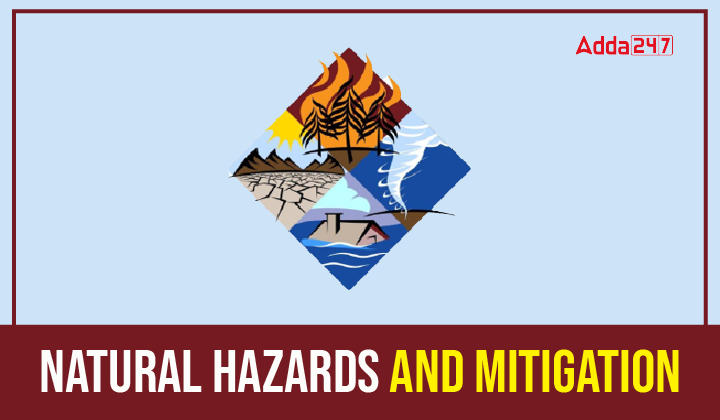Table of Contents
Natural hazards are events or phenomena that occur naturally and have the potential to cause harm to people, property, or the environment. These hazards arise from natural processes and include earthquakes, floods, hurricanes, tornadoes, wildfires, volcanic eruptions, tsunamis, landslides, droughts, and more. Mitigation involves taking actions and implementing measures to reduce or minimize the impacts of these natural hazards. In this discussion, we will explore detailed study notes on natural hazards and their mitigation strategies.
UGC NET Study Notes for Paper 1
What is Natural Hazards
Natural hazards are extreme events or processes that occur naturally and can cause harm, damage, or disruption to people, infrastructure, and the environment. They are beyond human control and can result from geological, meteorological, or biological phenomena. These hazards have various forms and impacts, from localized events to large-scale disasters. Dealing with natural hazards requires comprehensive approaches involving preparedness, response, and mitigation strategies.
What is Mitigation
Mitigation refers to actions and measures taken to reduce or minimize the impacts of natural hazards. Mitigation strategies can include a range of activities such as risk assessment, land-use planning, structural measures, early warning systems, education and awareness programs, ecosystem management, insurance and financial strategies, and international cooperation. Mitigation involves actions and strategies aimed at minimizing the negative effects of natural hazards.
Natural Hazards and Mitigation Types
Natural hazards are events or processes occurring in the natural environment that pose a threat to human life, property, and the environment. They include phenomena such as earthquakes, floods, hurricanes, wildfires, landslides, volcanic eruptions, and tsunamis. To mitigate the impact of natural hazards, various types of mitigation measures can be implemented. Here are some common types of natural hazards and their corresponding mitigation approaches:
Geophysical hazards
- These are associated with the Earth’s internal processes and can cause severe damage. Earthquakes, resulting from the release of tectonic stress, can lead to ground shaking, ground rupture, and subsequent destruction of buildings and infrastructure.
- Landslides occur when masses of soil, rock, or debris move down slopes, endangering lives and blocking transportation routes.
- Tsunamis, often triggered by undersea earthquakes or volcanic eruptions, produce massive ocean waves that can devastate coastal regions.
- Volcanic eruptions release ash, lava, and toxic gases, threatening nearby populations and their livelihoods.
Hydrological hazards
- These are linked to water and can cause extensive damage.
- Avalanches are rapid downhill movements of snow, ice, and debris, posing risks to communities in mountainous regions.
- Floods occur when rivers or other bodies of water overflow their banks, resulting in the inundation of low-lying areas and causing damage to infrastructure and property.
Climatological hazards
- These are associated with long-term weather patterns and climate conditions.
- Extreme temperatures, whether excessively hot or cold, can strain human health, impact agriculture, and disrupt ecosystems.
- Droughts, characterized by prolonged periods of low precipitation, can lead to water scarcity, crop failure, and economic hardship.
- Wildfires, often exacerbated by dry conditions, spread rapidly and threaten both natural habitats and human settlements.
Meteorological hazards
- These encompass atmospheric phenomena that can result in hazardous conditions.
- Cyclones, including hurricanes, typhoons, and tornadoes, are powerful storms that can cause widespread destruction through high winds, heavy rainfall, and storm surges.
- Severe storms, such as thunderstorms and hailstorms, can produce damaging winds, lightning strikes, and hail, leading to property damage and endangering lives.
Biological hazards
- These are related to living organisms and can have significant impacts on human health.
- Disease outbreaks and epidemics, caused by infectious agents like bacteria, viruses, or parasites, can spread rapidly within populations, resulting in illness, death, and social disruption.
By understanding the nature of these hazards and implementing proactive measures, societies can enhance their resilience and minimize the devastating consequences they may bring. While it is impossible to entirely eliminate the risks, informed decision-making, adequate resources, and collective efforts can significantly reduce their impact on human lives and safeguard our communities.
Download Natural Hazards and Mitigation Study Notes PDF
| UGC NET Related Articles | |
| UGC NET Notification 2025 | UGC NET Application Form 2025 |
| UGC NET Previous Year Question Paper | |




 Odisha LTR Question Paper 2025, Check Su...
Odisha LTR Question Paper 2025, Check Su...
 HPSC Assistant Professor Final Answer Ke...
HPSC Assistant Professor Final Answer Ke...
 HPSC Assistant Professor Question Paper ...
HPSC Assistant Professor Question Paper ...




